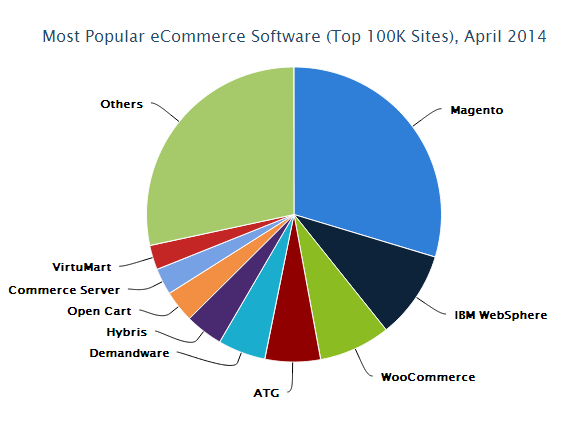
Once we had a great talk with a guy who is extremely popular co-founder of Meanbee and known as Magento guru - Tom Robertshaw. But the largest share of his popularity is gained thanks to the in-depth e-Commerce surveys which keep informed and up-to-date the global community of merchants together with platform developers. More than a decade ago, in 2014, Tom enriched his blog with one more detailed e-commerce survey insights from 2014. He asked, what shopping cart was leading the world then, and what were the top 100K busiest sites?
For this survey Tom has used a statistics provided by Alexa that appears to be an Amazon-owned company. Accordingly to the presented data the number one popular platform was Magento with a significant market share at the time. Second best was claimed to be the most known WordPress plugin - WooCommerce. Some analytics may feel strange about that as it has been considered a solution for small web stores with a kind of limited opportunities. However, as it is said: “Homer sometimes nods” and this shopping cart had surpassed all expectations for sure.
Other top leaders of the survey were PrestaShop and OpenCart with notable market shares. They straightened their positions and increased the rates considerably. OpenCart experienced significant growth due to new version releases and functional improvements. Also, there is no surprise that Shopify had increased its rates offering a number of updates and opportunities like Payments, POS System and Shopify Mobile.
However, not all platforms feel pleasant changes in their popularity. Zen Cart and osCommerce continued to go down on the rates being those shopping carts which have forgotten about enhancements and updates.

The survey indicated that a substantial number of online shops were found among the top 100K busiest sites. Its survey showed clearly that the world’s leading shopping cart, Magento, had the most stores in this category. Magento notably led this category, showing significant growth from the prior year. IBM WebSphere and ATG Web Commerce took second and fourth place like a traditional Enterprise products. And WooCommerce, emerging as a strong contender, secured a top position in this survey.

Therefore, Tom Robertshaw made a great and useful analysis of situation on e-Commerce which can stir into making conclusions by people who have any attitude to digital market. And if you have a strong desire to get your store to one of the top leader platforms and do it in a double!
Monthly Update – December 2025
As the year draws to a close, the acceleration of AI integration into e-commerce reaches new heights, fundamentally reshaping how businesses interact with customers. Beyond basic product recommendations, AI in December 2025 is driving predictive analytics for inventory management, hyper-personalized customer journeys from discovery to post-purchase support, and sophisticated fraud detection systems. Retailers are deploying AI-powered virtual shopping assistants that offer style advice, compare products, and even facilitate virtual try-ons, dramatically enhancing the online shopping experience. This evolution demands robust, scalable infrastructure capable of handling vast datasets and complex algorithms. Merchants planning platform migrations in the coming year should prioritize solutions that offer deep AI integration capabilities and flexible APIs to stay competitive. The ability to seamlessly connect AI services with your core e-commerce platform will be a key differentiator, enabling unprecedented levels of efficiency and customer satisfaction. Embracing these advanced AI tools is no longer an option but a necessity for sustained growth in a dynamic digital landscape.
For more details, explore our FAQ section or schedule a call with a migration expert.



